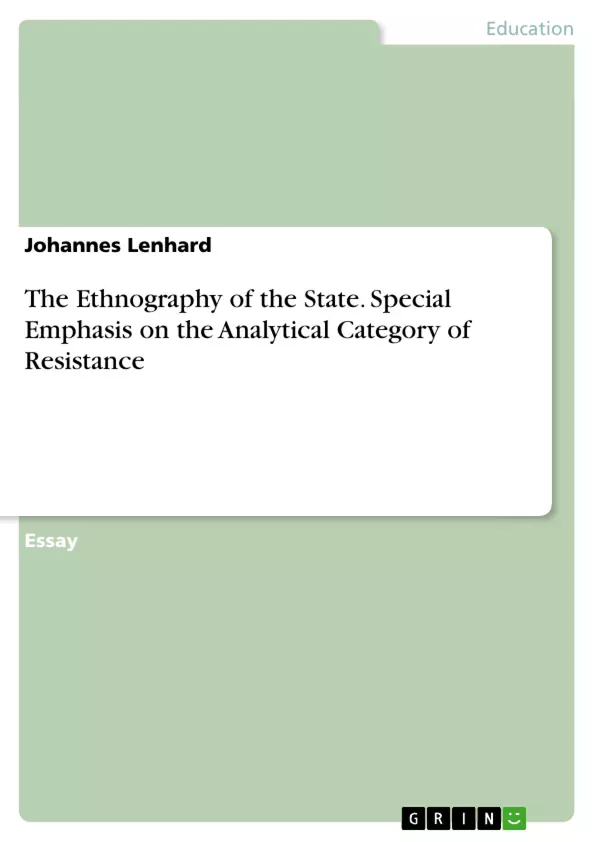Ethnographies of the state have undergone increased scrutiny over recent years. There are several reasons for that: Weber’s famous definition of the state as the ‘human community successfully claiming the monopoly of the legitimate use of physical force within a given territory’ has been contested by state-deniers such as Radcliffe-Brown (1940/2006) or later ‘fetishists’ including Abrams (1988) and Taussig (1992). They acknowledged the need to pin down the state in practices of everyday life rather than as an abstract ‘fetishised’ unity. Most recently, heightened influence of globalised companies ('corporate turn', Kapferer, 2005), NGOs and transnational organisations such as the IMF and the world bank (Trouillot, 2001) dispersed centres of sovereignty even further. Following historical developments, the study of the state has come full turn from Hobbes’s ‘Leviathan’ to Foucault’s ‘capillaries’. I will briefly mention several different ethnographic analytics that can help to still trace the state and its effects in this multi-dimensional context – introducing notions of institutions, culture and history as locations for state power – before I focus on the study of a seemingly non-state political expression: resistance. I examine Abu-Lughod’s (1990) mighty claim that where we find resistance, there is power (i.e. the state) with the help of ethnographic case studies from Egypt (Ali, 1996), Botswana (Comaroff, 1985), Malaysia (Scott, 1989), India (Nandy, 1983) and Turkey (Navaro-Yashin, 2002).
Inhaltsverzeichnis (Table of Contents)
- Ethnographies of the State
- Weber's Definition of the State
- State-Deniers
- Globalisation and the State
- From 'Leviathan' to 'Capillaries'
- Ethnographic Analytics of the State
- Resistance as an Analytic Category
- Abu-Lughod's Inversion
- Everyday Practices and Resistance
- The Paradox of Material Dependency and Resistance
- ‘Hidden Resistance' and Consciousness
- Thickness of Resistance
Zielsetzung und Themenschwerpunkte (Objectives and Key Themes)
This text seeks to explore the multifaceted nature of the state and its power structures, specifically through the lens of resistance. It critically analyzes the changing role of the state in a globalized world, moving beyond the traditional Weberian definition. Key themes explored include:- The evolving nature of the state in the face of globalisation and the rise of new actors such as corporations, NGOs, and transnational institutions
- The analytical potential of resistance as a tool to understand power dynamics and the state's influence
- The significance of everyday practices and 'hidden resistance' in challenging state authority
- The role of cultural factors, particularly religion, in shaping both state power and forms of resistance
- The importance of understanding the 'thickness' of resistance, incorporating internal politics, cultural dimensions, and historical contexts
Zusammenfassung der Kapitel (Chapter Summaries)
The text starts by examining the traditional Weberian definition of the state, which emphasizes its monopoly on legitimate violence within a territory. It then critiques this definition through the work of state-deniers such as Radcliffe-Brown, Abrams, and Taussig, who emphasize the need to understand the state in everyday practices rather than as an abstract entity. The text then discusses the impact of globalisation and the emergence of new actors, such as transnational corporations, NGOs, and international institutions, on the state's authority. This shift from a central 'Leviathan' to a more 'capillary' form of power is explored, highlighting the importance of studying the state in its diverse manifestations, including institutions, culture, and history. The second part of the text focuses on the concept of resistance as an analytical tool for understanding the state. It begins with Abu-Lughod's claim that resistance reveals power dynamics, challenging the notion that resistance solely speaks to the ineffectiveness of the state. The text then examines various ethnographic case studies from Egypt, Botswana, Malaysia, India, and Turkey to explore different forms of resistance, including everyday practices, 'hidden resistance,' and cultural expressions. The text continues by discussing the paradox of material dependency and resistance, as illustrated by the example of Saniye, a cleaning lady in Turkey who relies on state services but also engages in everyday resistance. It also explores the role of consciousness and the possibility of 'hidden resistance' in shaping political processes. Finally, the text delves into the importance of understanding the 'thickness' of resistance by considering its historical context, internal politics, and cultural dimensions. Examples from Egypt, Botswana, and India illustrate how cultural factors, such as religion, can shape both state power and forms of resistance.Schlüsselwörter (Keywords)
This text focuses on key concepts such as the state, resistance, power, globalisation, transnational actors, everyday practices, 'hidden resistance,' cultural dimensions, and the 'thickness' of resistance. It explores the interplay between these concepts to provide a nuanced understanding of the state and its relationship with resistance in a contemporary context.- Citar trabajo
- Johannes Lenhard (Autor), 2013, The Ethnography of the State. Special Emphasis on the Analytical Category of Resistance, Múnich, GRIN Verlag, https://www.grin.com/document/230434



